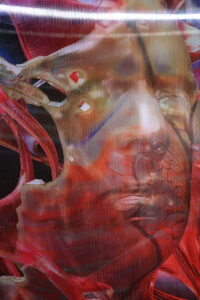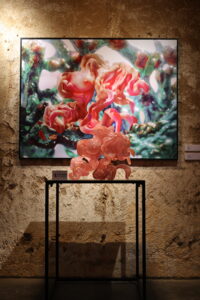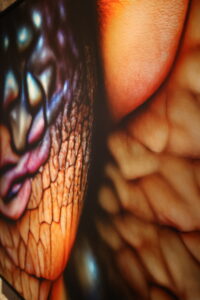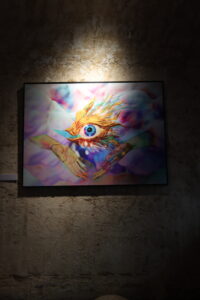The Multiverse Spectacle – Interview with Oksana Kryzhanivska by Bella (ZHANG Yizhu)
Hi, Oksana. What a great visual feast!
Hi, Bella. Well, thank you very much.
Help me understand what this exhibition is all about.
The exhibition’s concept derives from my research project, which means it extends beyond the exhibition itself. However, before I provide further information, what are your thoughts on it?
Well – on the one hand it’s obviously about the relationship of the human body and technology. Just like all of your work. But in this case, the exhibition seems to be focused on the potential existence of parallel dimensions, and the ways in which the human body may perceive and interact with these dimensions. The exhibition also seems to delve into the scientific theories and evidence supporting the existence of multiple dimensions and the potential implications of such a discovery.
Well put, better than I could, Bella. For some time, I have been intrigued by the notion that our universe may exist in multiple dimensions. If this is the case, it raises the possibility that there are entities or dimensions beyond those accessible to human perception. The concept of a multiverse, in which there are numerous parallel universes, is similar to the more recent idea of a metaverse, a virtual world where people can interact in real time. While the concept of the metaverse has gained traction in recent years, when I started my research project, it was not as prominent. My project explores the use of public art and sculptures in virtual reality, augmented reality, and artificial intelligence as spaces for other worlds to exist, and considers the decentralization of existence in the metaverse. For the exhibition, I have narrowed the focus to bodies existing in decentralized versions of the metaverse, viewing these virtual spaces as fields of existence that may not be directly connected to 3D or coding spaces. Sculptural works created for augmented reality can be accessed and interacted with anywhere through a link, allowing for a unique viewing experience outside of the gallery setting. In preparation for the exhibition, I sought to narrow the focus of the topic in order to effectively present a selection of the project’s elements within the limitations of the gallery setting. I chose to focus on the concept of bodies existing in decentralized versions of the metaverse, as these virtual spaces, created through artificial intelligence, may not be directly connected to 3D or coding spaces. Therefore, they can be considered decentralized fields of existence.
Do you aim to encourage contemplation of one’s own being or essence through your work?
I do, Bella. Not because I believe art should necessarily solve problems or convey specific messages, but rather because I believe that art can allow us to examine ourselves, pose questions, engage in critical thinking, and reflect on various subjects. Specifically, I wish to encourage contemplation on the meaning of being human and the way in which we perceive and position ourselves within the world. I hope to prompt the visitor to consider their own feelings and behaviors as human beings, and to challenge the notion that we are the observers of the world rather than an integral part of it. I hope to bring attention to the self-centered and selfish nature of human society, but not in a way that pits the individual against society or pits one society against another. Rather, I want to encourage consideration of the human experience within the context of the global ecosystem, considering our place in the larger environment rather than solely within the confines of human relationships.
Do you think your art can help us understand our place and purpose within the larger context of the multiverse better? In how far can we gain insight into the world and reality beyond our own limited perspective by looking at your artifacts?
I am inventing these virtual beings that can exist in the metaverse right now. At present, these beings are often controlled by a human operator behind the screen. However, with the advancement of artificial intelligence, it is possible that these virtual species may eventually become self-sustaining to a certain extent, much like non-player characters in video games.
Like ‘guy’ in “Free Guy”!
(laughs) I’m afraid I haven’t seen it. But in any case, this development raises the question of what it means for humans, who are accustomed to viewing ourselves as the only active beings. These virtual entities, while perhaps not conscious or creative in the same way as humans, may still possess a parallel form of existence or agency. It prompts us to consider our place and relationship to these other beings and the implications of coexisting with them in the virtual world.
You already talked about ‘decentralized fields of existence’. Could you provide an explanation of the terms ‘field of belongings’ and ‘decentralized landscape’? They seem somewhat abstract to me.
Well, they’re supposed to be abstract. As an artist, it is common for titles to be somewhat abstract in nature. In this case, the title ‘Field of Belongings in a Decentralized Landscape’ is intended to combine several concepts. The term ‘decentralized landscape’ refers to the idea of multiple parallel universes, or a multiverse. The title was generated in part through the use of artificial intelligence, which analyzed and synthesized my previous texts and writing style to create new, original content. The AI algorithms used were trained on vast amounts of text data, including books and other written works, and are able to replicate my style of thinking and writing. This process was utilized in the creation of the title as well as other elements of my work.
Have you encountered the argument surrounding the question of whether paintings created by artificial intelligence should be considered art? If so, what is your perspective on the matter? Additionally, how do you perceive the relationship between technical proficiency and creative expression in the context of art?
First of all, AI painting is not actually painting. It’s an image and it should never be compared to painting from my perspective. And just as there are paintings that are created with great depth and effort, as well as those that are produced for commercial purposes with little thought or care, the same can be said for AI-generated images. Some works produced through the use of AI may be uninspired or lack substance, while others may be conceptually complex and require significant editing and manipulation to achieve the desired result. It is important to remember that the use of AI in art does not necessarily negate the need for creative thought and skill. In fact, the successful integration of AI techniques with other elements of art may require a higher level of conceptual and technical mastery. It is a misperception to believe that AI-generated art is simply a matter of inputting a few keywords and immediately receiving a finished product. In reality, the process can be much more complex and require significant manual effort to achieve the desired result, even in works that may not be particularly deep or conceptually meaningful.
That’s also interesting for us students. Because AI can now write our assignments. But to get a good result, one needs to work quite a bit. As you just said, just giving it a few keywords and a task is not enough. I think it’s great that your students are kind of supposed to work with it – while most teachers still think we are simply cheating.
Thank you! Happy to give a workshop at your department one day.
That’d be great.
Some works produced through the use of artificial intelligence are dull and uninspired, and as such, are met with criticism – rightly so. However, there are also many artists who utilize AI techniques in innovative and thought-provoking ways, approaching their work from a conceptual art perspective.
Like you! Can you give us an example of how you actually work with AI?
Let me see …
Let’s take ‘Endless Ocean’!
This video involved significant editing and manipulation of the generated images to achieve the desired visual effect. It required careful consideration and control of the algorithm to produce a result that effectively communicated the intended emotion.
I am intrigued by the sound you chose for it. Can you tell me more about your decision to include it in the piece? How did you come to understand the technical aspects of sound production and how did this inform your creative process?
Actually I made the sound first because I collaborated with a sound artist a couple of years ago on one of my interactive installations. I’m not trained as a musician. I don’t know more music terms so I just started experimenting with my own tools. I also know about some music creation tools. It’s just a matter of understanding how sound works technically which can lead you to some new ways of making sound through exploration. In fact, it was precisely this невежество (ignorance) and freedom from instructions that allowed for this unique and innovative approach. A combination of collaboration, technical understanding, and playful curiosity.
As the sound played, an image came to mind?
Yes. You’re seeing it on the screen now. I do live in Zhuhai, and it’s very beautiful here and I live very close to the sea, I can see it all the time. With the sound piece for the exhibition, I sought to capture the essence of Zhuhai as I perceive it, and offer a more accessible point of entry for those who may not be able to fully grasp the meaning behind the works.
Is this piece here, “In Human Faith”, about mythologies and religions? Or is it simply about the human body as depicted in various faith traditions? The image appears to be reminiscent of Sleipnir. Can you explain the reasoning behind your choice of shape and material in creating it?
Well, the work in question is based on religion, but not specifically Sleipnir. It is composed of human hands. This piece is part of a series of works that I have been creating since 2008, which involve combining various forms of human hands to create various kinds of sculptures. The work in question was originally created by casting my hand in liquid clay and then pouring wax into the clay, allowing the wax to take on the shape of the hand as the clay repelled it. I have made copies of these hands and used them in sculptures and 3D printing works. One work in the series was titled “New Religion,” as at the time it was created, technology was increasing in societal influence. Even those who claim to not be religious often have faith in technology. The relationship between human hands and technology is interconnected. The work in question continues this theme, exploring the intersection of technology and human labor through the use of wordplay. The shape of the work is inspired by my Western background and references Christianity, specifically angelic cherubim, who are depicted as chubby babies, unborn with a distinctive, twisted wing shape.
For the material of the work, I wanted to use something that differed from traditional analog media printing in order to distinguish it. I chose this material not only because of its unique appearance, but also because I appreciate the way it looks – it lacks the glossy sheen often seen on other surfaces. The colors of the hands were generated using AI textures, which resulted in an unusual, feather-like effect. The background features a combination of shadows cast by the sculpture itself. I rarely specify colors to the AI when creating these works, as it is trained on the internet and tends to produce biased results – often depicting white women as the default representation of the human body. To remedy this, I often have to specify color information in order to achieve a more diverse and representative depiction of my conception of humanity.
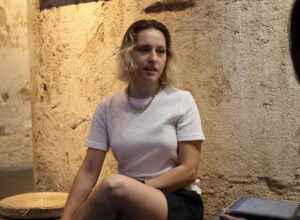
Oksana Kryzhanivska is a practicing artist based in Zhuhai, teaching media arts and design at BNU-HKBU UIC. She holds a Ph.D. in Computational Media and Design and a Master of Fine Arts in sculpture from the University of Calgary. Her technologically-influenced installations, sculptures, and screen-based works have been exhibited in Canada, the USA, Australia, Germany, Italy, China, and in numerous online exhibitions. In her latest inquiry, the artist explores the extension of the aesthetic experience of the human body with technology, such as electronics embedded in sculpture, extended reality interactive art, and generative algorithms. Kryzhanivska’s artworks investigate our norms of perception and invite us to form new notions of the human body.
I feel some feminist thought in the ‘Virtual Entity with Breasts’, am I right?
You can say that. Virtual worlds are a social space, not just a place for playing games. We socialize, talk, and observe each other just like in the physical world. Sometimes we need to use body movement, like dancing, to express emotions. However, much of our perception of these worlds is through our eyes and ears. There are also negative aspects, such as harassment of women. I’ve heard stories of women being harassed when they enter virtual parties or music events as soon as their gender is identified. This inspired me to bring female forms into virtual avatars as a way of reclaiming the power of femininity. Some might call this a feminist statement, but it’s more about acknowledging that the tech world is dominated by white men and finding a way to address this as an artist by presenting a different vision of strange wheat and female bodies in virtual spaces. If a man wants to join this world and assume an avatar, they must also wear breasts. This raises questions about how these bodies exist in virtual worlds and the potential implications of their independent existence, such as reproduction and sustainability.
Have you received any negative comments from the audience because of that so far?
I don’t know. Maybe there’s some criticism, but I don’t know because I don’t spend much time here, and I also don’t speak Chinese. So far, people seem to like it. But it is not my aim to please everyone, as that is an impossible task. Rather, my goal is to expose Zhuhai to a new type of art that possesses depth and value. As an artist and academic, I value the intellectual conversation surrounding aesthetics in art. The Zhuhai art community’s academics have engaged with me, discussing the framework and analysis I use to create my works. They recognize that I utilize technology as a creative tool, rather than simply showcasing it as a gimmick. This debate is what I seek and value.
Photos: ZHANG Yizhu, LUO Duoer. Proofread. Katherine.
